| 1、为什么要使用框架?
框架是一组自动化测试的规范、测试脚本的基础代码,以及测试思想、惯例的集合。可用于减少冗余代码、提高代码生产率、提高代码重用性和可维护性。例如QTestWare就是QTP自动化测试框架中的一类。
2、SAFFRON简介
SAFFRON是针对Web开发的一个简单的QTP测试框架原型,是Adam Gensler于06年写的,需要QTP 9.1版本以上。完整的SAFFRON脚本代码可到以下地址获取:http://www.itestware.com/ctest/index.php?option=com_content&view=article&id=62:webqtp-saffron&catid=35:testing_is_believing
3、如何使用SAFFRON?
SAFFRON框架以外部VBS文件的形式出现,因此使用方法比较简单,直接在测试脚本中以资源形式导入即可使用,如图所示:
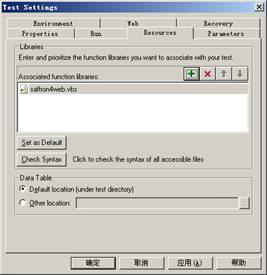
导入后,可在“Available Keywords”视图中看到SAFFRON的所有函数,如图所示:
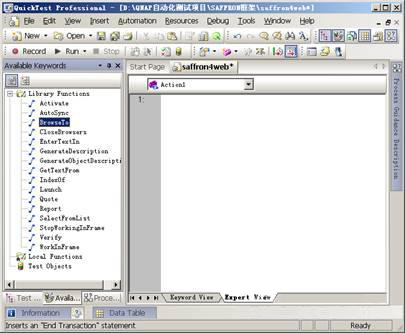
选中某个函数,拖拽到专家视图的编辑器中,如图所示:
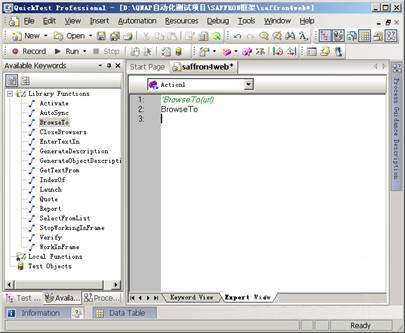
后接一个URL地址,例如“http://www.itestware.com”,即可使用SAFFRON框架中的BrowseTo函数导航到指定的URL地址,如下脚本所示:
'BrowseTo(url)
BrowseTo "http://www.itestware.com"
4、SAFFRON框架代码剖析
为了深入了解SAFFRON,以及框架的使用方法,下面我们将分别介绍SAFFRON中的主要函数,对SAFFRON代码进行深入剖析。
4.1 导航到指定URL
SAFFRON使用名为BrowseTo函数来负责导航到指定的URL,如果浏览器尚未启动,则先调用函数Launch来打开浏览器。BrowseTo函数的定义如下所示:
Public Function BrowseTo (url)
thirdlevel = ""
Report micPass, "Navigate to
URL", "Navigating to URL: " & Quote(url)
If initialized Then
Execute GenerateDescription("Browser")
& "Navigate " & Quote(url)
Else
Launch "website",
url
End If
Reporter.Filter = rfDisableAll
End Function
在脚本中,会判断是否初始化了浏览器,如果有则执行导航动作,导航到指定的URL。导航动作是执行这行脚本来完成的:
Execute GenerateDescription("Browser")
& "Navigate " & Quote(url)
Execute是一个用于执行指定VBScript脚本语句的函数,GenerateDescription函数的定义如下所示:
' Generates a generic description based
up on the "level" viarable
' levelstr - will be one of the values
that is in the level array
' returns - string representative of the
object hierarchy
Public Function GenerateDescription (levelstr)
l = IndexOf(level, levelstr)
If l >=0 Then
fdesc = level(0) & "("
& Quote(desc(0)) & ")."
If l >= 1 Then
fdesc = fdesc + level(1)
& "(" & Quote(desc(1)) & ")."
If 2 >= l Then
If thirdlevel <>
"" Then
fdesc = fdesc
+ level(2) & "(" & Quote(desc(2)) & ","
& Quote("name:=" & thirdlevel) & ")."
End If
End If
End If
End If
GenerateDescription =
fdesc
End Function
4.2 返回测试对象的描述
GenerateDescription函数用于返回对象的描述性语句,例如,指定Browser,则返回如下语句:
"Browser("micclass:=Browser")."
该语句代表了当前浏览器对象,并且后面加了个点号,这是为了方便后接"Navigate "这个浏览器对象的导航操作,以及指定的URL字符串,例如"http://blog.csdn.net/testing_is_believing"。在Execute时,其实执行的VBScript语句如下所示:
Browser("micclass:=Browser").Navigate
"http://blog.csdn.net/testing_is_believing"
经过SAFFRON的框架封装后,则只需要使用如下语句即可达到同样的效果:
BrowseTo "http://blog.csdn.net/testing_is_believing"
4.3 启动浏览器
SAFFRON使用名为BrowseTo函数来负责导航到指定的URL,但是如果浏览器未启动,则会先调用函数Launch来打开浏览器。Launch函数的定义如下所示:
prepares the framework for usage, and configures
all internal framework
' variables and structures
' apptype - used to launch different types
of applications based
'
upon different technologies -- currently there is only web
' val - string
that represents what to launch
' returns - always returns true
Public Function Launch (apptype, val)
If "website" = apptype
Then
thirdlevel = ""
Report micPass, "Initialize",
"Initializing Framework"
level = split(webLevels, leveldelimiter,
-1, 1)
desc = split(webLevelsDesc,
leveldescdelimiter, -1, 1)
object = split(objects, objectdelimiter,
-1, 1)
objectDescription = split(objectsDescription,
objectsDescriptiondelimiter, -1, 1)
CloseBrowsers
Set IE = CreateObject("InternetExplorer.Application")
IE.visible = true
IE.Navigate val
While IE.Busy
wait 1
Wend
End If
initialized = true
Launch = true
End Function
可看到脚本中创建了IE的COM对象,然后设置IE的Visible属性设置为Tue,让浏览器可见,然后调用IE对象的Navigate方法导航到指定的URL。除了创建IE的COM对象外,在Launch函数中还进行框架其它方面的初始化。
4.4 给指定字符串前后加双引号
在BrowseTo函数的定义脚本中,调用了一个名为Quote的函数,该函数的定义如下所示:
' generates a string with embedded/surrounding
quotes
Public Function Quote (txt)
Quote = chr(34) & txt & chr(34)
End Function
该函数的作用是给指定的字符串前后加上双引号字符,例如下面代码
Msgbox "The message is " &
Quote("hello world!")
执行结果显示如图所示。
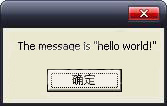
如果我们不使用这个函数,则需要这样写我们的代码来实现同样的功能:
Msgbox "The message is ""hello
world!"""
很明显,这样的写法写出来的代码的可读性和可维护性都差一截。
4.5 点击链接
作为一个针对WEB应用的脚本框架,除了能启动浏览器导航到指定的页面外,还需要针对页面的各种元素进行测试操作,例如链接的点击、按钮的点击操作。在SAFFRON框架中,使用Activate函数来点击链接、按钮,其函数定义如下所示:
' Activates an object based upon its object
type
' objtype - the type of object should be
limited to values in the object array
' text - identifying
text for the control - for a link, it's the text of the link
Public Function Activate (objtype, text)
localDesc = ""
If thirdlevel <> ""
Then
localDesc = GenerateDescription(level(2))
Else
localDesc = GenerateDescription(level(1))
End If
AutoSync()
Select Case objtype
Case "Link"
Execute localDesc & GenerateObjectDescription("Link","innertext:="
& text) & "Click"
Report micPass, "Link
Activation", "The Link " & Quote(text) &
" was clicked."
Case "WebButton"
Execute localDesc & GenerateObjectDescription("WebButton",
"value:=" & text) & "Click"
Report micPass, "WebButton
Activation", "The WebButton " & Quote(text) &
" was clicked."
End Select
End Function
函数首先判断对象的类型,然后根据对象类型分别处理,如果是链接对象,则通过以下语句组合成可执行的VBScript语句,然后用Execute函数来执行:
Execute localDesc & GenerateObjectDescription("Link","innertext:="
& text) & "Click"
如果是按钮对象,则组合成:
Execute localDesc & GenerateObjectDescription("WebButton",
"value:=" & text) & "Click"
在这里,调用了GenerateObjectDescription函数,GenerateObjectDescription函数的作用与GenerateDescription函数的作用类似,都是用于返回一个测试对象的描述,不同的是GenerateObjectDescription函数需要传入测试对象的描述数组,GenerateObjectDescription函数的定义如下:
' Generates an object description based
upon the object, and objectDescription arrays
' obj - name of the object in the object
array
' prop - additional property to help uniquely
identify the object
' returns - a string representative of
the object description
Public Function GenerateObjectDescription
(obj, prop)
i = IndexOf(object, obj)
ndesc = ""
If i <> -1 Then
ndesc = obj & "("
& Quote(objectDescription(i)) & "," & Quote(prop)
& ")."
End If
GenerateobjectDescription = ndesc
End Function
有了Activate函数,我们在写脚本的时候就可以充分利用,简化脚本的编写,例如下面是两句简单的脚本,分别点击页面上的一个链接和一个按钮:
Activate "Link", "Person"
Activate "WebButton", "Search"
在Activate函数中,调用了一个名为AutoSync的函数,该函数的作用与QTP的Sync方法是一样的,只是在外面封装了一层,函数定义如下所示:
' waits for the web page to finish loading
Public Function AutoSync
Execute GenerateDescription("Browser")
& "Sync"
End Function
AutoSync函数用于等待WEB页面加载完成。
4.6 一个小例子
到现在为止,我们可以使用SAFFRON的Launch、BrowserTo和Activate函数来编写简单的脚本启动浏览器,导航到指定的页面,点击链接和按钮,例如下面就是一个综合了这几个功能的脚本:
' 启动浏览器
Launch "website","http://127.0.0.1:1080"
' 导航到“http://127.0.0.1:1080/WebTours”
BrowseTo "http://127.0.0.1:1080/WebTours/"
' 点击名为“administration”的链接
Activate "Link","administration"
该脚本调用SAFFRON框架的Launch函数启动IE浏览器,然后导航到“http://127.0.0.1:1080/WebTours”,点击如图所示的页面中名为“administration”的链接。
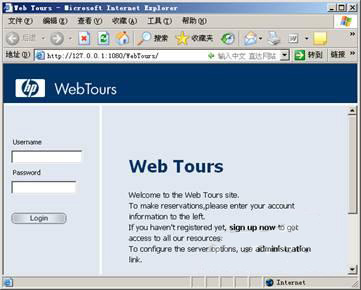
脚本的测试结果如图所示。
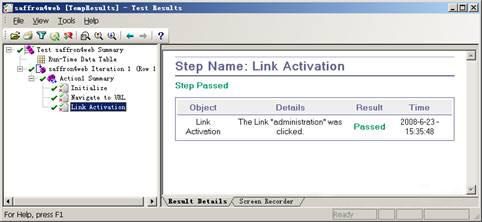
4.7 检查对象是否存在
前面的小例子仅仅实现了启动浏览器、导航、点击链接和按钮的功能,如果要组成一个完整的测试用例,还缺少一些东西,例如检查指定的对象是否存在,在SAFFRON中,用Verify函数来实现这个功能,Verify函数的定义如下所示:
' Verify the Existence of an object
' objtype - values should be limited to
values in the object array
' text - multi-purpose
argument that indicates what to verify
'
- for a link, or button, it's the text of the control
'
- for a list, it's the name of the control
'
- for a frame, it's the name of the frame
Public Function Verify (objtype, text)
rval = false
localDesc = ""
estr = ""
If thirdlevel <> ""
Then
localDesc = GenerateDescription(level(2))
Else
localDesc = GenerateDescription(level(1))
End If
AutoSync()
Select Case objtype
Case "Page"
Execute "rval = "
& GenerateDescription(level(1)) & "Exist (0)"
If rval Then
Execute "title =
" & GenerateDescription(level(1)) & "GetROProperty("
& Quote("title") & ")"
If title = text Then
rval = true
Else
rval = false
End If
End If
Case "CurrentFrame"
If thirdlevel <> ""
Then
estr = "rval = "
& localDesc
End If
Case "Link"
estr = "rval = "
& localDesc & GenerateObjectDescription("Link",
"innertext:=" & text)
Case "WebButton"
estr = "rval = "
& localDesc & GenerateObjectDescription("WebButton",
"value:=" & text)
Case "WebList"
estr = "rval = "
& localDesc & GenerateObjectDescription("WebList",
"name:=" & text)
Case "WebEdit"
estr = "rval = "
& localDesc & GenerateObjectDescription("WebEdit",
"name:=" & text)
End Select
If estr <> "" Then
Execute estr + "Exist
(0)"
End If
If rval Then
Report micPass, objtype &
" Verification", "The " & objtype &
" " & Quote(text) & " was verified to exist"
Else
Report micFail, objtype &
" Verification", "The " & objtype
& " " & Quote(text) & " was not found"
End If
If "True" = rval Then
rval = True
Else
rval = False
End If
Verify = rval
End Function
由于判断不同对象的存在需要采用不同的属性,因此Verify函数中对不同的对象类型进行判断、分别处理。例如,对于Link类型的对象,用innertext属性,对于WebButton,则采用value属性,但是最后都需要组合成一条语句,后接“Exist”,通过Execute方法执行这个语句,从而实现对象是否存在的判断。
对于页面对象(Page)的存在性检查有点不一样,采用的是以下脚本:
Case "Page"
Execute "rval = "
& GenerateDescription(level(1)) & "Exist (0)"
If rval Then
Execute "title =
" & GenerateDescription(level(1)) & "GetROProperty("
& Quote("title") & ")"
If title = text Then
rval = true
Else
rval = false
End If
End If
通过GetROProperty方法获取当前页面的title属性,然后与传入的“text”参数进行比较,如果相等,则认为页面对象是存在的。
在测试脚本中可以这样使用Verify函数:
' 启动浏览器
Launch "website","http://127.0.0.1:1080"
' 导航到“http://127.0.0.1:1080/WebTours”
BrowseTo "http://127.0.0.1:1080/WebTours/"
If Verify ("Link","administration")=
False then
Reporter.ReportEvent micFail,"检查链接","链接不存在"
Else
' 点击名为“administration”的链接
Activate "Link","administration"
End IF
脚本中先用Verify检查名为“administration”的链接对象是否存在,如果不存在则提示错误,如果存在则进一步调用Activate函数点击链接。
4.8 在文本框输入字符串
在SAFFRON中,可以使用EnterTextIn函数来给输入框(WebEdit对象)输入字符串。EnterTextIn函数的定义如下所示:
' Enters text into an edit field
' objname - name of the control -- use
Object Spy if you don't know what it is
' text - the text to
enter into the control
Public Function EnterTextIn (objname, text)
localDesc = ""
rval = true
If thirdlevel <> ""
Then
localDesc = GenerateDescription(level(2))
Else
localDesc = GenerateDescription(level(1))
End If
AutoSync()
localDesc = localdesc & GenerateObjectDescription("WebEdit",
"name:=" & objname)
Execute localDesc & "Set
(" & Quote(text) & ")"
Report micPass, "Enter Text",
"Text: " & Quote(text) & " was entered into
" & Quote(objname)
EnterTextIn = rval
End Function
例如,如果我们要在如图所示的登录界面中输入用户名和密码,则可以使用SAFFRON的EnterTextIn函数来实现。
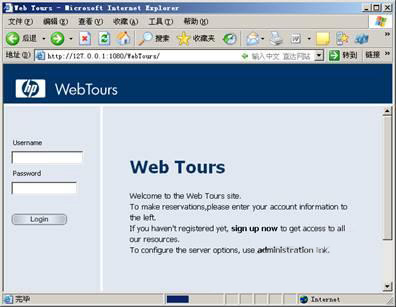
测试脚本可以这样编写:
' 输入用户名
EnterTextIn "username","chennengji"
' 输入密码
EnterTextIn "password","123"
4.9 读取文本框的字符串
在SAFFRON中,可以使用EnterTextIn函数来给输入框(WebEdit对象)输入字符串。对应的有一个名为GetTextFrom的函数,用于读取输入框和文本列表的字符串,GetTextFrom的定义如下所示:
' Obtains text from a control
' objtype - is the type of control the
get the text from
' objname - is the name of the control
-- use Object Spy if you don't know the name
' returns - the text of the control
Public Function GetTextFrom (objtype, objname)
text = ""
localDesc = ""
If thirdlevel <> ""
Then
localDesc = GenerateDescription(level(2))
Else
localDesc = GenerateDescription(level(1))
End If
AutoSync()
Select Case objtype
Case "WebEdit"
Execute "text =
" & localDesc & GenerateObjectDescription("WebEdit",
"name:=" & objname) & "GetROProperty ("
& Quote("value") & ")"
Case "WebList"
Execute "text =
" & localDesc & GenerateObjectDescription("WebList",
"name:=" & objname) & "GetROProperty ("
& Quote("value") & ")"
End Select
Report micPass, "Capture Text",
"Text: " & Quote(text) & " was captured from
the control " & Quote(objname)
GetTextFrom = text
End Function
假设我们需要读取如图所示的界面中的“Departure City”和“Arrival City”这两个文本列表(WebList对象)中的字符串,则可以使用GetTextFrom函数。
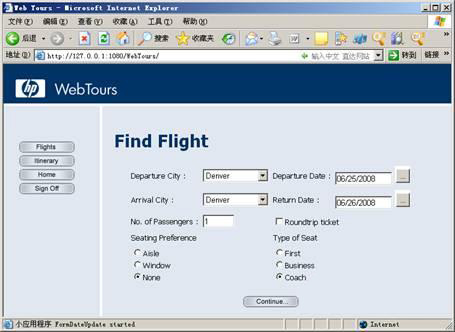
测试脚本可以这样编写:
' 获取航班起始城市
DepartureCity = GetTextFrom( "WebList","depart")
' 获取航班终点城市
ArrivalCity = GetTextFrom( "WebList","arrive")
当然,也可以使用相同的函数来读取文本框(WebEdit对象)的字符串,例如下面的脚本读取“NO. of Passengers”对应的文本框中的字符串:
' 获取乘客数量
PassengerNumber = GetTextFrom( "WebEdit","numPassengers")
4.10选择列表中的一项
在SAFFRON中,可以使用SelectFromList函数从下拉框列表(WebList对象)中选择指定的一项。SelectFromList的定义如下所示:
' Selects a specific value from a listbox,
or combobox
' objname - name of the control -- use
Object Spy if you don't know the name property
' text - the item in
the combobox to select
Public Function SelectFromList (objname,
text)
localDesc = ""
rv = ""
rval = false
If thirdlevel <> ""
Then
localDesc = GenerateDescription(level(2))
Else
localDesc = GenerateDescription(level(1))
End If
AutoSync()
localDesc = localdesc & GenerateObjectDescription("WebList",
"name:=" & objname)
Execute "cnt = " &
localDesc & "GetROProperty(" & Quote("items
count") & ")"
For i = 1 to cnt
Execute "rv = " &
localDesc & "GetItem (" & i & ")"
If rv = text Then
rval = true
End If
Next
If rval Then
Execute localDesc & "Select
" & Quote(text)
End If
If rval Then
Report micPass, "WebList
Selection", "The WebList item " & Quote(text)
& " was selected."
Else
Report micFail, "WebList
Selection", "The WebList item " & Quote(text)
& " was NOT found."
End If
SelectFromList = rval
End Function
假设我们需要从如图所示的界面中的“Departure City”的下拉框中选择其中一项,则可使用SelectFromList函数来实现。
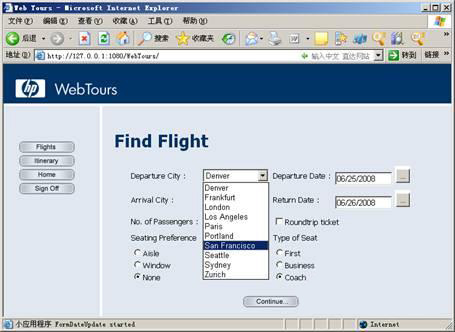
测试脚本可以这样写:
' 选择航班起始城市为"San Francisco"
SelectFromList "depart","San
Francisco"
4.11 关闭浏览器
Web页面测试的最后一个步骤一般都是关闭浏览器,在SAFFRON中,也把这个过程封装成了一个名为“CloseBrowsers”的函数,该函数的定义如下:
' close all opened browsers
Public Function CloseBrowsers
If Browser("micclass:=Browser").Exist
(0) Then
Browser("micclass:=Browser").Close
End If
While Browser("micclass:=Browser",
"index:=1").Exist (0)
Browser("index:=1").Close
Wend
If Browser("micclass:=Browser").Exist
(0) Then
Browser("micclass:=Browser").Close
End If
End Function
CloseBrowsers函数会把当前所有打开的浏览器都关闭,脚本中采用描述性编程的方式获取所有对象类型为“Browser”的测试对象,然后循环逐个关闭所有这种类型的测试对象。
5、对SAFFRON框架进行扩展
SAFFRON是一个基本的框架,它封装了浏览器的相关测试操作、封装了一些基本对象的测试操作,例如Link、WebButton、WebEdit、WebList等控件,可用于基本的WEB页面的测试,并且简化了测试脚本的编写,可以让代码的可读性和可维护性得到增强。
但是SAFFRON仅仅是一个基础框架,我们还需要进一步地对其扩展才能应用到实际的WEB自动化测试项目中去,例如扩展对更多的控件的支持。下面是一个对Activate函数扩展Image对象的点击操作的过程:
(1)首先打开SAFFRON框架的VBS文件,找到开头的变量定义处,添加Image对象,让框架可以识别和支持Image对象:
' 扩展对Image对象的支持
objects = "Link|WebButton|WebList|WebEdit|Image"
objectsDescription = "micclass:=Link|micclass:=WebButton|micclass:=WebList|micclass:=WebEdit|micclass:=Image"
(2)修改Activate方法,添加对Image对象的Click操作的支持,脚本修改成如下所示:
' Activates an object based upon its object
type
' objtype - the type of object should be
limited to values in the object array
' text - identifying
text for the control - for a link, it's the text of the link
Public Function Activate (objtype, text)
localDesc = ""
If thirdlevel <> ""
Then
localDesc = GenerateDescription(level(2))
Else
localDesc = GenerateDescription(level(1))
End If
AutoSync()
Select Case objtype
Case "Link"
Execute localDesc & GenerateObjectDescription("Link","innertext:="
& text) & "Click"
Report micPass, "Link
Activation", "The Link " & Quote(text) &
" was clicked."
Case "WebButton"
Execute localDesc & GenerateObjectDescription("WebButton",
"value:=" & text) & "Click"
Report micPass, "WebButton
Activation", "The WebButton " & Quote(text) &
" was clicked."
' 扩展对Image类型的按钮的支持
Case "Image"
Execute localDesc & GenerateObjectDescription("Image",
"alt:=" & text) & "Click"
Report micPass, "ImageButton
Activation", "The ImageButton " & Quote(text)
& " was clicked."
End Select
End Function
(3)调试和测试修改后的脚本,例如采用下面的脚本来看对Activate函数的扩展是否生效:
' 启动浏览器
Launch "website","http://127.0.0.1:1080"
' 导航到“http://127.0.0.1:1080/WebTours”
BrowseTo "http://127.0.0.1:1080/WebTours/"
' 输入用户名
EnterTextIn "username","chennengji"
' 输入密码
EnterTextIn "password","123"
' 单击Login按钮
Activate "Image","Login"
' 单击"Flights"按钮
Browser("Web Tours").Page("Web
Tours").Frame("navbar").Image("Search Flights
Button").Click
' 获取航班起始城市
DepartureCity = GetTextFrom( "WebList","depart")
' 获取航班终点城市
ArrivalCity = GetTextFrom( "WebList","arrive")
' 获取乘客数量
PassengerNumber = GetTextFrom( "WebEdit","numPassengers")
' 选择航班起始城市为"San Francisco"
SelectFromList "depart","San
Francisco"
If Verify ("Link","administration")=
False then
Reporter.ReportEvent micFail,"检查链接","链接不存在"
Else
' 点击名为“administration”的链接
Activate "Link","administration"
End IF
脚本的测试结果如图所示:
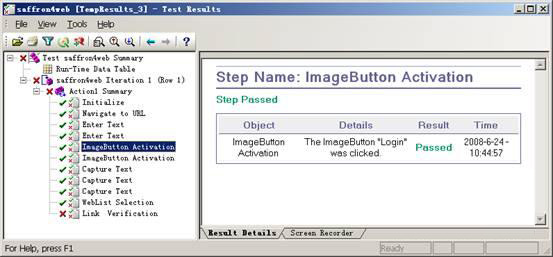
|









